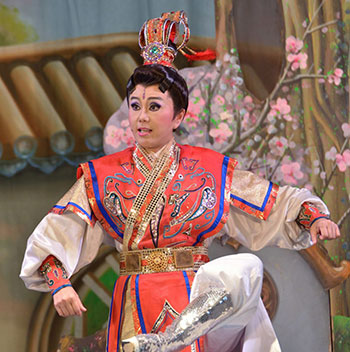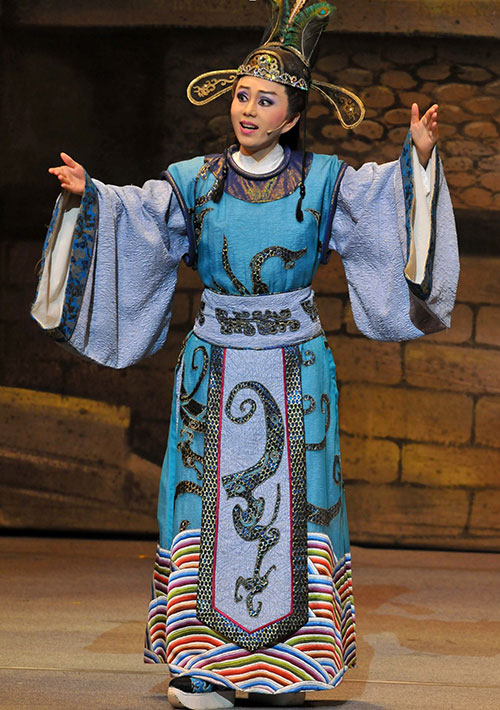Stories
Many Taiwanese Opera performances are inspired by local stories, folklore, and historical events. Scripts often portray themes of loyalty, filial piety, and romantic love, enhancing its cultural relevance and resonance among the Taiwanese people. Today, themes such as mother-in-law and daughter-in-law relationships, dementia, and family dynamics have been incorporated into Taiwanese Opera plots. This connection to local narratives strengthens the bond between the art form and its audience.
Roles

Shēng (Male Role)
In Taiwanese Opera, male roles are significant, as they often play the protagonist in the stories. There are three main types of male roles in this traditional art based on the age of the character and their actions. The first type is Xiǎo Shēng, a gentle and elegant character who frequently pairs up with the female lead (Xiǎo Dàn). Xiǎo Shēng is a fan favorite. Lǎo Shēng is a middle-aged character with a beard, requiring detailed gestures and a calm voice. Lastly, Wǔ Shēng embodies the warrior archetype on stage, showcasing adeptness with weapons. Wǔ Shēng is portrayed as a mighty and powerful hero akin to an action star in Western movies.

Dàn (Female Role)
In Taiwanese Opera, there are two main types of female roles. The first is Xiǎo Dàn, the female lead known for her moving and emotional singing voice. Xiǎo Dàn's character is celebrated for its beauty, elegant postures, delicate looks, and charming demeanor, captivating the audience, and garnering admiration. The second type is Lǎo Dàn, portraying an elderly woman who typically expresses love for her children through overindulgence and protection, adhering strictly to rules and etiquette, reflecting a deep sense of tradition.

Jìng (Strong Male Role)
In traditional Taiwanese Opera, there is no specific character category like Jìng. However, influenced by Peking Opera techniques, characters like Jìng have emerged, such as Lord Guan, the God of Battles, who feature distinct facial painting with prominent strokes like a big flower. These characters are known for their calmness, stability, majestic presence, intimidating strength, and regal style.

Chǒu (Jester)
The performances of the Chǒu characters are predominantly comical and amusing, akin to jesters and clowns. During the early stages of Taiwanese Opera, clowns held a prestigious position in the theater. These actors exhibit flexibility, lightheartedness, humor, wit, and resourcefulness. By portraying eccentric and mischievous roles, they engage with the audience on a personal level, creating a unique blend of tragedy and comedy in their characterization.
Acts and Postures
The body movements in Taiwanese Opera are a strictly standardized and stylized performance method. Actors in Taiwanese Opera utilize various body movements, including eye expressions, gestures, and footsteps, to convey the personalities, emotions, and specific situations of the characters. This technique is commonly referred to as "footsteps and gestures" among enthusiasts of the art form.
Costumes
In Taiwanese Opera, characters' identities and genders are predominantly conveyed through the costumes they wear. These costumes can be classified into five main categories: gender, social status, personality, and formality.
In the realm of Taiwanese Opera, colors play a symbolic role, representing various meanings. For instance: Black symbolizes bravery, wisdom, and straightforwardness. Red is associated with loyalty, bravery, and generally positive traits. White typically signifies a villainous character. Purple indicates mightiness and uprightness. Pink is often used for females or portraying elderly characters. Yellow represents explosiveness and bravery. Gold is a symbol of immortality. Silver is commonly associated with fairies or monsters. Green suggests bravery and recklessness, while blue signifies strength.
Makeup
Makeup holds a significant role in Taiwanese Opera performances as it conveys crucial information about the character's personality, gender, and social status. Traditionally, Taiwanese Opera makeup was characterized by its vibrant, colorful, and dramatic nature. However, contemporary Taiwanese Opera actors rarely use such elaborate makeup styles, with the exception being classic characters deeply ingrained in the audience's memories. Nowadays, most Taiwanese Opera makeup leans towards a natural and realistic aesthetic.
Music and Tunes
There are four main and most common singing tunes in Taiwanese Opera: Qīzì Tune, Kū Tune, Zá niàn Tune, and DūmǎTune. These four singing tunes do not have completely fixed melodies. Instead, they follow the tones of the Taiwanese language and align with the words to maintain the 'harmony of poetry and music.

Qīzì Tune
Scholars and experts often emphasize that Taiwanese Opera is the only native opera of Taiwan because of the unique music style of Qīzì tune. Not only is it the most representative element of Taiwanese Opera, but it is also the only essential music form within the genre. Named after its characteristic structure of four sentences with seven characters each, it is also known as “Gēzī tune”. This music style not only embodies a strong Taiwanese local flavor but is also so prevalent that it holds a dominant and indispensable role in nearly every performance. A Taiwanese opera without the presence of Qīzì tune can hardly be considered a true representation of the art form.

Kū Tune
It is primarily utilized in situations involving crying or mourning and encompasses various types. This style was prevalent during the period of in-door Taiwanese Opera, characterized by its mournful tone and melancholic melodies, reflecting the people's hardships and sorrows of the time. Among the commonly used ones are “Big Crying Tune”, “Měng Jiǎ Crying”, “Yílán Crying”, “Zhānghuà Crying”, and more. Additionally, “Jiāngxī tune” and “Qiónghuā tune” fall under the category of crying tunes. During particularly sorrowful events, performances of crying tunes are often presented in series, with one song following another continuously, resembling a suite.

Zá niàn Tune
Commonly known as “Miscellaneous Thoughts”, this style is typically delivered in a manner akin to recitation or chanting while singing with a rapid pace. The Zá niàn tune does not have a fixed number of sentences in each paragraph, nor is there a fixed length for each sentence, hence its name. The number of words in the lyrics matches the number of notes in the melody, with one word per note. It is frequently employed in lengthy narratives or intricate storylines.

DūmǎTune
In 1948, the Xiàmen Dūmǎ Opera Troupe from China arrived in Taiwan to perform. The primary singing style of the reformed opera (Taiwanese Opera) they presented—known as “Chop Suey Tune” -- was highly acclaimed by the Taiwanese audience. Taiwanese opera troupes referred to it as “Dūmǎ Tune.” This singing style is often characterized by its slow tempo, making it suitable for narrative, lyrical, expressive, and playful occasions. The lyrics are usually formed by seven words in a sentence and two couplets (four sentences) as a set. Its melodious and pleasing melodies have been widely adopted by Taiwanese Opera performers and have become popular in performances.
Photo and Audio Credit:
https://www.facebook.com/mhyfans/photos?locale=zh_TW(The Ming Hua Yuan Facebook page was hacked on 3/24. Fortunately, we were able to download the images before this event occurred.)
https://www.facebook.com/mhysun?locale=zh_TW
https://www.youtube.com/watch?v=pA_Id5L7i-E
https://www.youtube.com/watch?v=LZrBVcxMosw
https://www.youtube.com/watch?v=ANBPpri91Gw
https://www.youtube.com/watch?v=gtzwLcm0hcc




























